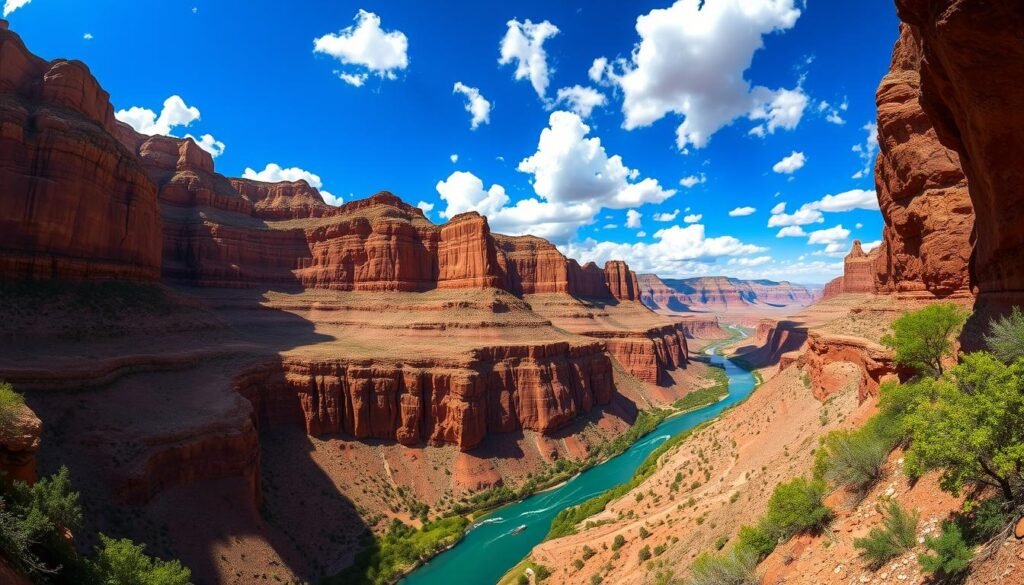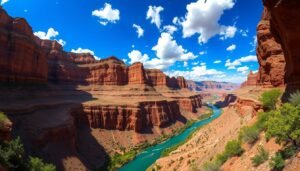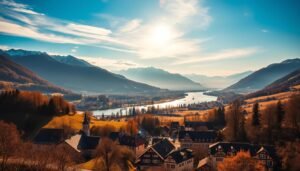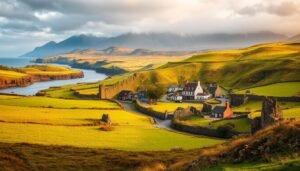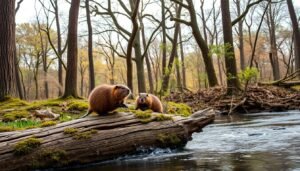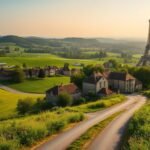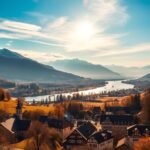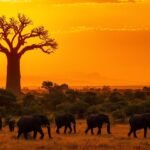Did you know the Grand Canyon stretches about 277 miles long and can span up to 18 miles wide, a scale that still surprised me on my first trip.
I explored this state across spring blooms and mild fall days, and I found much more than desert. Volcanic ranges, pine forests, and deep canyons changed the view every hour.
I framed this guide around practical road trip loops and city hubs like Phoenix and Tucson, so you can plan a trip that balances iconic sightlines with relaxed detours. I flag seasonal tips, sunrise and sunset timings, and simple pass or permit notes that saved me time.best-time-to-visit-portugal
If you like mixing museum mornings with red-rock sunsets, this short roadmap shows how to string destinations together without burning out—or missing the standout things that make the trip memorable.
Key Takeaways
- The Grand Canyon’s immense scale defines much of the state’s allure.
- Spring and fall offer the most comfortable travel weather and wildflower displays.
- Use Phoenix or Tucson as flight hubs for easy car rentals and road loops.
- I pair big-name attractions with smaller cultural and foodie stops for variety.
- Simple planning steps—timing, passes, and pace—keep a trip relaxed and fun.
Why I Think Spring Is the Perfect Time to Visit Arizona
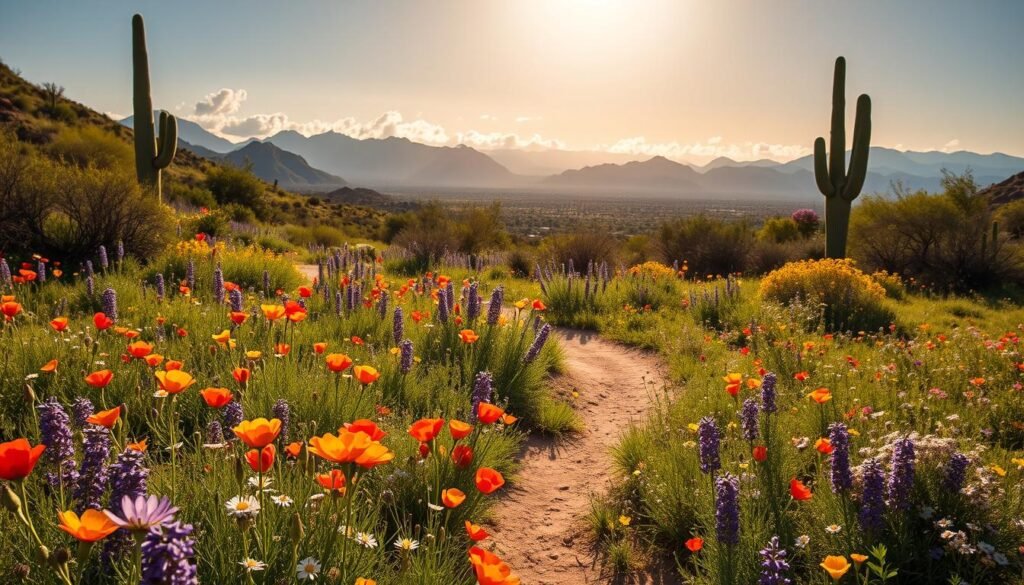
Arriving in spring, I found the heat tempered and the desert carpeted with color. The season offered a sweet balance of warm days and cool nights, which made every outing feel comfortable and energizing.
Blooming deserts and mild temps: what won me over
Spring brought wildflower bursts and saguaro blooms that turned short walks into memorable moments. The Desert Botanical Garden in Phoenix stood out — cactus flowers and curated displays made even an hour feel rich with discovery.
I planned my trip for spring because temperatures were comfortably warm. That meant I could stack more experiences into a day without melting in midday heat.
How I avoided crowds and timed sunrise/sunset for the best views
I used sunrise and sunset as my travel strategy. Early mornings showed softer light and empty overlooks, while evenings gave me long golden-hour views without the heat.
“By arriving early to headline sights, I beat the tour rush and found parking—small wins that made the trip smoother.”
- I booked marquee viewpoints and short hikes in the morning, then saved museums and patios for the warmer afternoons.
- Spring events like spring training added variety, so I left flexible slots in my itinerary.
- I always carried layers for big day-to-night swings and shifted late-spring outings earlier to avoid afternoon warmth.
Overall, spring gave me clear views, floral color, and thinner crowds—exactly the mix I wanted for a relaxed desert trip.
Grand Landscapes: National Parks You Can’t Miss
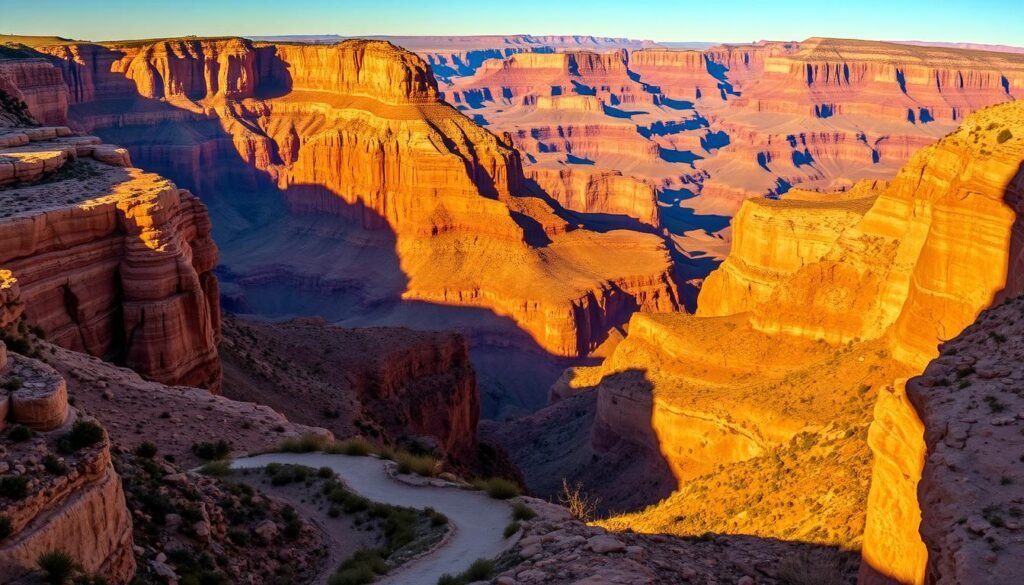
Wide vistas and stark color shifts made each park stop feel like a new chapter of the trip. I visited three national parks that offer very different scenes and easy road connections.
Grand Canyon National Park — South Rim and short hikes
I began on the South Rim for cinematic viewpoints, then walked part of the Bright Angel Trail to sense the scale. The canyon runs about 277 miles and reaches up to 18 miles wide. Sunrise and sunset here are unforgettable.
Saguaro National Park — giants and spring blooms
I split time between the Rincon Mountain District (East) for longer hiking and mountain views, and the Tucson Mountain District (West) for denser saguaro forests. Spring wildflowers made short trails pop with color.
Petrified Forest National Park — painted badlands and ancient logs
The Painted Desert and Blue Mesa felt otherworldly. Short walks led me past petrified wood and sites like Agate House that link deep time with human history.best-places-to-visit-in-february
| Park | Highlights | Top activity |
|---|---|---|
| Grand Canyon National Park | South Rim viewpoints, Bright Angel Trail, Colorado River context | Hiking & stargazing |
| Saguaro National Park | East mountain drives, West saguaro forests, spring blooms | Scenic loops & photos |
| Petrified Forest National Park | Painted Desert, Blue Mesa, Agate House | Short walks & geology |
“I found canyon grandeur, living desert, and fossil-rich badlands fit neatly on one flexible road loop.”
Iconic Southwest Vistas: Monument Valley and Page Area Canyons
![]()
A short detour along the road brought me face-to-face with vast red buttes and slot-canyon light that stopped me mid-step.
Monument Valley Navajo Tribal Park
Monument Valley lived up to its cinematic reputation. I paused at John Ford’s Point for that classic panorama and took a guided Navajo tour to reach deeper viewpoints and hear local history.
The self-drive Valley Drive is doable in a regular car, but a high-clearance vehicle made the bumpy loops easier for me.
Antelope Canyon
In Page I compared Upper and Lower Antelope Canyon. Upper shows dramatic mid-day light beams from March through October. Lower is narrower and more intimate, with ladders and tight turns.
Navajo-led tours added cultural context and kept crowds moving. I booked early and padded my schedule for photography time.best-places-to-visit-in-january
Horseshoe Bend and Glen Canyon
For Horseshoe Bend I aimed for late morning or midday to reduce shadows on the Colorado River curve. A wide-angle lens captured the sweep best.
- I used Page as a 1–2 day hub: Antelope Canyon and Horseshoe Bend one day, Glen Canyon overlooks or a boat trip the next.
- Hydrate, plan shade breaks, and book tours early for a smoother experience.
things to do in Page helped me plan the timing and logistics for this packed but rewarding stretch.
best places to visit in arizona: My Handpicked Cities and Cultural Hotspots
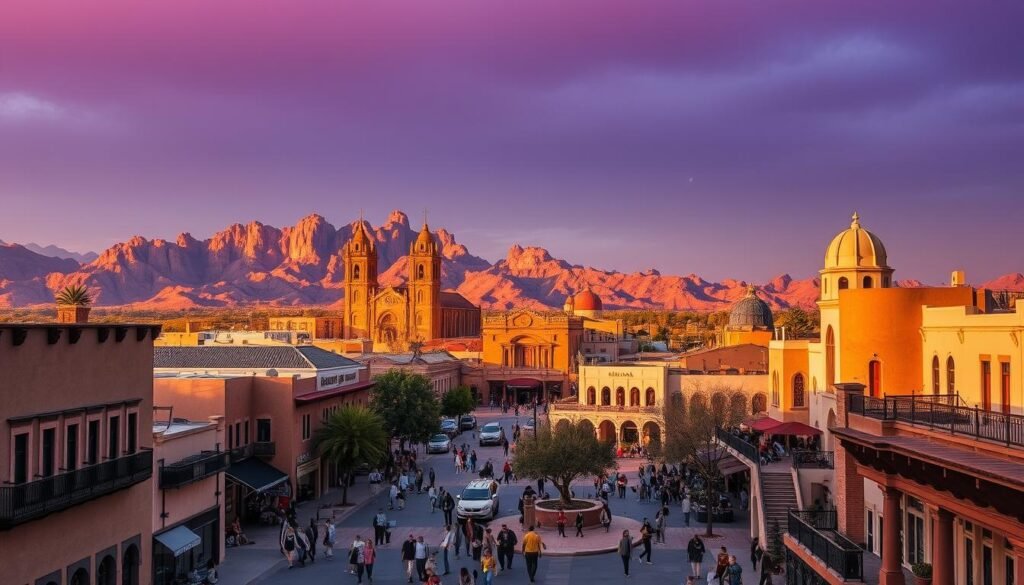
I made each city a short base and let neighborhoods, galleries, and nearby trails shape my days. This mix kept the pace lively and practical for a weeklong trip.
Sedona
Sedona married red-rock hiking with an active art scene. I walked short trails at sunrise, then gallery-hopped in town for local prints and jewelry.
Vortex overlooks at sunset gave the rocks a fiery glow that felt cinematic and calm at once.
Tucson
In Tucson I split time between Mission San Xavier del Bac’s ornate chapel and a taco trail lunch in a historic district. The city’s food scene sustained long days.
Its location made it easy to reach both sides of saguaro national park for morning photos and late-afternoon shade.
Phoenix & Scottsdale
Phoenix surprised me with the Desert Botanical Garden and standout museums. Then I crossed into Scottsdale for Old Town art walks and lively patio dinners.best-places-to-visit-in-costa-rica
I booked short city tours when helpful, but mostly wandered on foot to find murals and local coffee spots.
Flagstaff
Flagstaff served as a cool-morning base. I drove a bit of Route 66, visited Lowell Observatory at dusk, and used the town as my high-country reset before desert days.
“I chose walkable districts for ease and safety, so I could savor galleries, short hikes, and evening patios without running a car every night.”
| City | Highlights | Why I liked it |
|---|---|---|
| Sedona | Red rocks, galleries, vortex overlooks | Close trails and strong art scene |
| Tucson | Mission San Xavier, historic neighborhoods, Mexican food | Gateway to saguaro national park and great eats |
| Phoenix & Scottsdale | Desert Botanical Garden, museums, Old Town | Museum hours and upscale dining |
| Flagstaff | Route 66, Lowell Observatory, pine country | Cool climate and stargazing |
Short on time? Sedona and Tucson pack culture and nature into a quick hit. For more anchor options and a fuller itinerary, see my roundup of top places visit arizona.
Small-Town Hidden Gems I Loved

Pulling off the highway, I discovered that the state’s quieter towns carried big personality in compact packages.
Bisbee: mining history, colorful streets, artsy spirit
Bisbee felt like a living museum. The town’s mining roots show up in hillside stairways and brick facades.
I took a mine tour that dropped me into the past. Then I wandered the colorful streets and found tucked-away galleries and cafes.
Jerome: haunted hillside, wine tasting, Douglas Mansion
Jerome rose from ghost-town days and leans into that story with charm.
I toured Douglas Mansion for context, browsed artist studios, and sampled local wines. Nightfall on its winding lanes felt deliciously eerie.
Patagonia: birding at Paton Center, lake time, Sky Islands calm
Patagonia was my quiet reset. I spent patient mornings at the Paton Center for hummingbirds and lazy afternoons at the lake.
These towns added personality between bigger stops — easy lunches, friendly people, and simple strolls that let me linger without a strict plan.best-places-to-visit-in-march
“I spaced them over two days so I could savor hilltop views and main-street discoveries.”
Historic Landmarks That Bring Arizona’s Story to Life
![]()
I traced Arizona’s story through landmarks that hold voices from cliff dwellers to frontier towns. These stops gave me a compact, living lesson in local history and culture.
Montezuma Castle National Monument
Montezuma Castle rises from a limestone face as a five-story cliff dwelling with about 20 rooms. The Sinagua people lived here over 600 years ago.
I viewed the site from the overlook trail and used the visitor center to learn why the structure mattered across the years.
Tombstone and Allen Street
Tombstone felt like stepping into Old West lore. Historic Allen Street still echoes with reenactments at the O.K. Corral and saloons that tell the boomtown history.
I strolled mid-morning, then toured museums and Boothill Graveyard for full context.
San Xavier del Bac and the Heard Museum
The late 18th-century San Xavier del Bac mission stunned me with baroque frescoes and ongoing conservation work.
Later, the Heard Museum in Phoenix showcased Indigenous arts and living culture exhibits that honored the people who shaped the region.
- These landmarks helped me connect architecture, art, and oral histories.
- If you plan a day loop, pair a mission with a museum for richer context.
“Talking with docents and staff deepened my sense of the people and years behind each site.”
Outdoor Adventures: Trails, Views, and Starry Nights
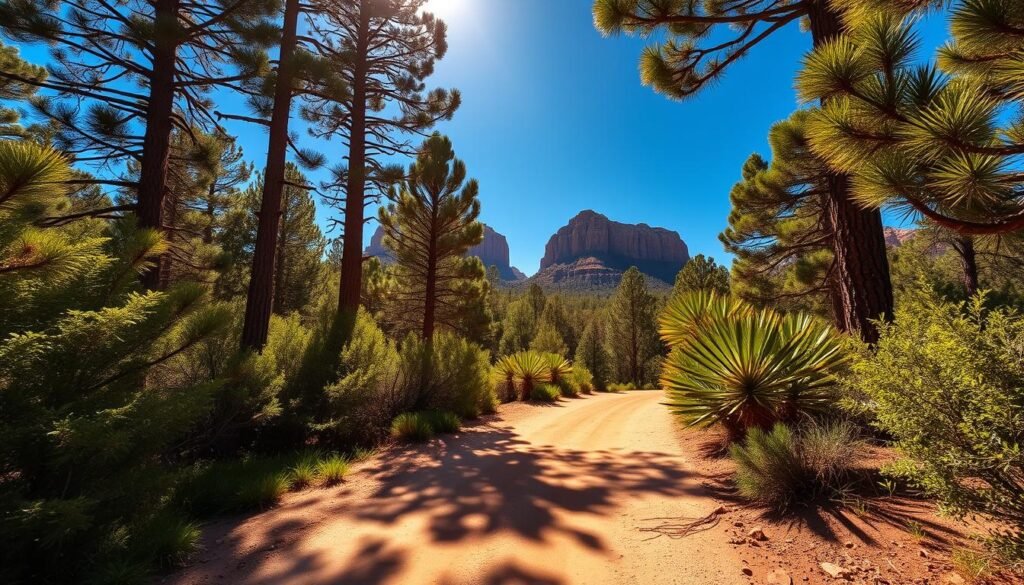
Some of my clearest memories came from long days on trails and a night under wide desert skies.
Sedona’s red rock playground
I mixed sunrise hiking with late-day Jeep tours to reach high viewpoints. Short loops kept me cool in the heat, and longer trails gave me a real workout when temperatures dropped.best-places-to-visit-in-switzerland
Sunset shots here are unforgettable; I timed golden hour for the best photos and softer air.
Havasu Falls: planning and canyon basics
Havasupai permits are essential for this canyon trek. The reward is surreal turquoise pools and dramatic red walls.
I packed extra water, electrolytes, and took a conservative pace. I stayed overnight to savor the pools and quiet.
Humphreys Peak summit day
The summit sits at 12,633 feet. The route is a 9.5-mile out-and-back with about 3,200 feet of gain.
I started early, watched weather, and gave myself a recovery day after the climb.
“These outdoor experiences balanced adrenaline and awe, with enough planning to keep everything fun and low-stress.”
| Spot | Key notes | Difficulty |
|---|---|---|
| Sedona | Wide trail variety, Jeep access, sunset views | Easy–Moderate |
| Havasu Falls | Permits required, turquoise pools, canyon camping | Moderate–Strenuous |
| Humphreys Peak | 12,633 ft summit, long gain, early start advised | Strenuous |
On the Water: Colorado River, Lake Powell, and More

I found relief and color on the water, where lakes and rivers rewrote my desert itinerary. Calm mornings on a kayak balanced the long drives and red-rock hiking that filled most days.
Lake Powell: houseboats, kayaking, Rainbow Bridge
Lake Powell became my base for slow water days. With nearly 2,000 miles of shoreline, I found quiet coves and easy launch points.
Houseboats turned a day into a mini-floating retreat. I kayaked into narrow inlets and cruised to see Rainbow Bridge National Monument.
Colorado River runs
The Colorado River offered everything from mellow floats to full whitewater. I booked a Black Canyon overnight paddle from Willow Beach for a different kind of night under stars.
Salt River escapes
Near Phoenix, the Salt River was my easy day escape. A lazy float, a picnic, and a few wild horses along the bank made for an unhurried afternoon.
“Water days slotted mid-trip kept energy high for the hikes and canyon stops that followed.”
- Pair an Antelope Canyon slot tour with a Lake Powell paddle for two canyons in one area-focused day.
- Pack dry bags, sun protection, and arrive early for popular launches along the road.
Road Trips That Made My Arizona Journey

Rolling miles under a huge sky, I found the road itself became the main attraction. I planned routes that mixed classic Americana with wide-open landscapes, and each drive offered its own rewards.
Route 66: classic diners and vintage museums
On Route 66 I followed neon signs and checked small museums along Arizona’s 385-mile stretch. I stopped for diner coffee, old gas stations, and quirky murals.
These retro spots carry real history and make a road trip feel like a slow, satisfying show.
Monument Valley Scenic Drive
The Monument Valley scenic road is a 17-mile dirt self-drive on Navajo land with an entrance fee. I drove slowly, used pullouts for photos, and paired the loop with a guided Navajo tour for deeper context.
Red Rock Scenic Byway (Highway 179)
Highway 179 is short but stunning near Sedona. I ran sunrise laps between hikes and dinners, and that brief drive gave huge views in minutes.
“Building loose plans let me pull over at oddball attractions—those spontaneous stops became favorites.”
- I packed a cooler for picnic pullouts.
- I downloaded offline maps and made a playlist for long stretches.
- I threaded towns into each route for coffee and easy pacing.
Wellness Retreats and Relaxing Stays
When I folded a wellness day into my route, the trip gained a calmer rhythm and clearer perspective. Wellness properties helped me reset between hikes and drives, giving me space for gentle routines and quiet reflection.
Mii amo & Enchantment Resort — spa days with red rock views
Mii amo gave me personalized journeys: guided meditation, tailored therapies, and slow mornings that felt restorative. At Enchantment Resort, casitas, outdoor pools, and sweeping red rock views made alternating trails and downtime effortless.
L’Auberge de Sedona — creekside calm and starry night
L’Auberge de Sedona delivered creekside dining and gentle water sounds that helped me unwind before treatments at L’Apothecary. I lingered by the stream, then watched stars come out at night.
Canyon Ranch Tucson & Miraval — integrative wellness in the Sonoran Desert
In Tucson, Canyon Ranch offered fitness classes, nutrition consults, and a large spa complex that felt like a full reset. Miraval focused on mindfulness, movement, and creative workshops that deepened my practice.
- I booked popular treatments early and left buffer time around sunset to enjoy the views.
- A mid-trip wellness day recharged me for active outings and kept the schedule balanced.
- Hydration and gentle morning stretches helped me move smoothly between spa sessions and trail time.
“If you only have time for one indulgence, pick the property that fits your vibe—creekside, red rock panoramas, or a desert sanctuary.”
For a desert sanctuary option I also looked into Castle Hot Springs as another peaceful choice. These stays shaped my trip more than I expected and added quiet, memorable experiences that stuck with me.
How I Planned My Trip: Timing, Permits, and Getting Around
I planned my route around seasonal highs and lows so each day felt doable and fun. That small rule shaped when I hiked, how far I drove, and which city I used as a base.
Best seasons by region
Spring and fall worked best for most desert and canyon days. Summer meant early starts or evening outings to avoid extreme heat. Winter gave me snowy high-country mornings around Flagstaff.
Permits and reservations
I set calendar reminders months ahead for The Wave lottery, Havasupai reservations, and Antelope Canyon tours. Booking early saved time and cut last-minute stress for guided tours and permits.
America the Beautiful Pass
I bought the America the Beautiful Pass for savings at national parks and federal sites. In Sedona it substituted for a Red Rock Pass for forest national park parking.
Airports and car rentals
I flew into Phoenix for central road trip access, used Tucson for Sonoran Desert days, and noted Laughlin/Bullhead for quick Colorado River jumps. I sketched daily miles and grouped nearby sites to avoid long drives.
“I left a light recovery day after big hikes, used offline maps, and charged backups—small moves that kept the trip smooth.”
| Topic | Key action | Why it helped me |
|---|---|---|
| Season planning | Spring/fall for deserts; winter for high country | Milder temps and safer hiking windows |
| Permits | Book The Wave, Havasupai, Antelope early | Secures tours and avoids sold-out dates |
| Pass & airports | Buy America the Beautiful; fly Phoenix/Tucson/Bullhead | Saves fees and shortens drives to key areas |
Conclusion
I wrapped the route with a few unhurried days that mixed signature views, small-town stops, and easy trail time. The balance of big panoramas and quiet lanes made each day feel like a fresh experience.
Start your plan with the Grand Canyon, Sedona, and Saguaro for an anchored first trip, then layer in towns like Bisbee or Jerome for local flavor. Spring’s mild weather and blooms made pacing easier, but a smart road trip schedule works any season.
Keep permits, the America the Beautiful Pass, and early bookings on your checklist. Make room for one surprise spot and slow meals—those small moves turned good days into great memories and unlocked the best things I found on the road.


